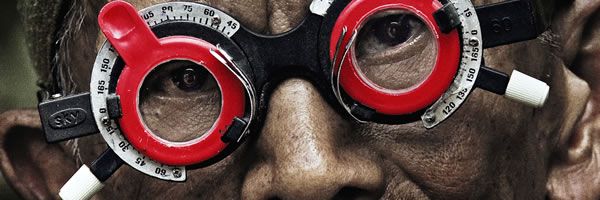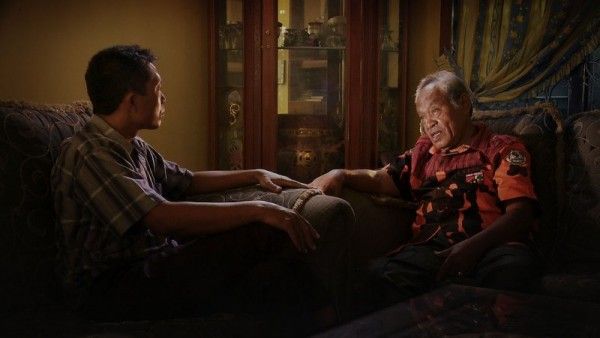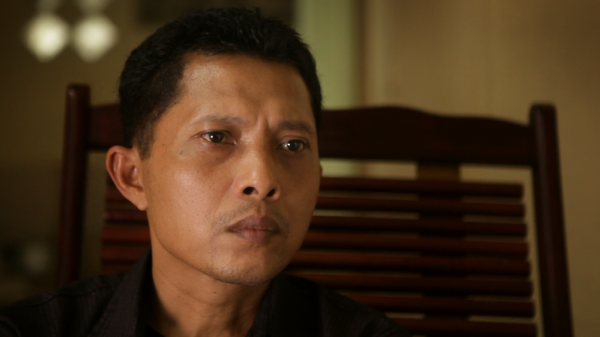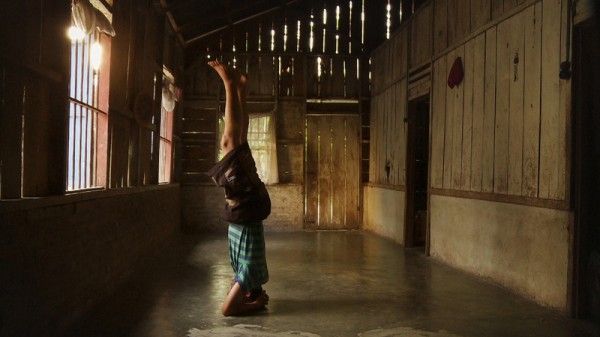In his devastating 2012 documentary The Act of Killing, director Joshua Oppenheimer took audiences on a nightmarish tour through a world where mass murderers not only avoided prosecution for their crimes; they could openly gloat about those crimes. Oppenheimer found an inspired and unique way to get one of the executioners to finally realize the gravity of his sins, but the director has now moved to a companion piece to let the victims have their say. Like its predecessor, The Look of Silence is yet another jaw-dropping work of non-fiction storytelling, and even though it walks more of a straight line than The Act of Killing, it still travels in the same haunting, upside-down world.
Adi is an optometrist who was born in 1968, two years after his brother Ramli was killed by a death squad at Snake River. Ramli’s death was part of a revolution that caused the death of a million people who were branded as “communist” simply by being declared enemies of the state. After Oppenheimer shows him video of a couple gloating death squad leaders reenacting Ramli’s murder, Adi goes to confront his brother’s killers. These conversations between Adi and the executioners are interspersed with interviews with Adi’s frail mother and even frailer father, who is blind, crippled, and nearly deaf. The whole said milieu is played against a backdrop of a nation that continues to indoctrinate its children and merely questioning the killers forty years after the fact is a highly risky endeavor.
Where as The Act of Killing was a hall of mirrors to reveal the truth, The Look of Silence is the necessary addition where we can’t just go inside the minds of the killers; we must also look at their victims. But yet again, Oppenheimer shows his brilliance in choosing his protagonist. Adi wasn’t even born yet when his brother died. He never knew his lost sibling, and that’s the point. It’s a loss represented by the million people who will never grow old and have families of their own. His loss is clearly personal to Adi, but it also represents every other victim who was slaughtered by death squads, not to mention those left behind who will forever mourn the loss of their friends and family.
It’s also fairly sly that Adi is an optometrist. Since this is a documentary, it’s possible that this is a coincidence. With The Act of Killing, Oppenheimer had his pick of killers that would love to be featured, and he settled on Anwar Congo. Judging by the number of Oppenheimer’s crew who chose be credited as a “Anonymous”, I suspect it was much harder to find a person willing to step forward and directly speak to the killers. Nevertheless, it’s perfect that Adi is trying to make people literally and figuratively see more clearly. But as you would expect, it’s much easier to accomplish the former than the latter.
Once again, Oppenheimer has made a film that makes my brain explode in a cacophony of rage, sadness, and sheer incomprehension. When one of the killers explains matter-of-factly that he had to drink his victims’ blood in order to stop from going insane, I was dumbstruck. What do you say to that? Obviously, there’s a level of madness involved in slaughtering hundreds of people and then boasting about it decades later. But this comment is a rare level of self-delusion, and it comes from more than one person.
One can’t help but wonder if this act of cannibalism is somehow the barest manifestation of guilt; that ritualizing the murder is a way of trying to normalize the behavior. We have to hope so. Even while watching video of one of the killer’s happily reenacting his crimes, Adi openly wonders if this isn’t bragging but a confession. Although it comes with a surprising implication of sympathy, Adi is still making a wish that some minor form of remorse might exist somewhere deep down in these awful people. And if not that, then perhaps God will sort of them out.
Picking up on these quiet, desperate desires is one of the ways that Oppenheimer shows himself to be a master documentary filmmaker as opposed to a guy with a camera who found a bunch of tragic stories. When Abi asks a killer a difficult question, the silence between them screams volumes. It’s in that moment where they both know the truth, but they also know that the perpetrator can never admit it. They’ll hide behind words like “politics” or the familiar, disgusting refrain of war criminals, “I was just following orders.” Perhaps the most shocking reply is one shared by the survivors: “The past is past.”
But to quote Faulkner, “The past is never dead. It’s not even past.” The past has been heavily distorted, but the people know the truth. They just have to stay silent about it. To break that silence is an act of bravery, and one that’s even more daring when you see schools indoctrinate students to a false narrative about the revolution. Breaking the silence is essential, but there’s the creeping fear about what it might even accomplish. If every killer fell to their knees and admitted their crime, would it bring solace to the victims? Adi’s father is so far gone into senility that he can’t even remember Ramli. Someone must speak for the dead, but where does that conversation lead? We can’t live with a lie, but how much will the truth accomplish at this point? It’s too late for real justice, which is why the victims pray that God will sort it out. Humanity has failed, so best leave it to the divine when demons roam free.
Rating: A-
Click here for all of our TIFF 2014 coverage. Click on the links below for our other TIFF 2014 reviews:
- Force Majeure
- Haemoo
- The Humbling
- Mr. Turner
- The Tale of Princess Kaguya
- What We Do in the Shadows
- Whiplash




